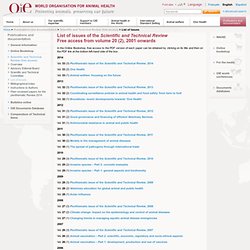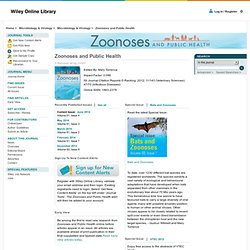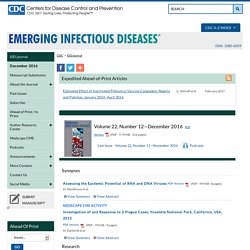

Vol 109, Isss 1–2, Pgs 1-178, (1 April, 2013) Scientific and Technical Review - OIE. In the Online Bookshop, free access to the PDF version of each paper can be obtained by clicking on its title and then on the PDF link at the bottom left-hand side of the box.

Vol. 33 (3) Plurithematic issue of the Scientific and Technical Review, 2014 Vol. 33 (2) One Health Vol. 33 (1) Animal welfare: focusing on the future Vol. 32 (3) Plurithematic issue of the Scientific and Technical Review, 2013 Vol. 32 (2) Coordinating surveillance policies in animal health and food safety ‘from farm to fork’ Vol. 32 (1) Brucellosis: recent developments towards ‘One Health’ Vol. 31 (3) Plurithematic issue of the Scientific and Technical Review, 2012 Vol. 31 (2) Good governance and financing of efficient Veterinary Services Vol. 31 (1) Antimicrobial resistance in animal and public health Vol. 30 (3) Plurithematic issue of the Scientific and Technical Review, 2011 Vol. 30 (2) Models in the management of animal diseases Vol. 30 (1) The spread of pathogens through international trade Vol. 28 (1) Avian influenza.
Ecosystem Health. Zoonoses and Public Health. Enjoy free access to the abstracts of VTEC 2012 Special Issue: Abstracts from the 8th International Symposium on Shiga Toxin (Verocytotoxin) Producing Escherichia coli Infections, 6-9 May 2012, Amsterdam, The Netherlands The research at this meeting focuses on a group of bacteria that reside in the intestine of cattle, and which contaminate the environment and many different kinds of food.

Human infection occurs in many different countries and in humans of all ages. Escherichia coli are a species of bacteria that varies widely in genomic and phenotypic characteristics. The toxin produced by this organism can cause diarrheal disease but can also lead to more severe damage to blood vessels, kidneys, brain and can produce thrombi. There were 540 attendees from 41 countries. Vector-Borne and Zoonotic Diseases. Latest Impact Factor* is 2.277 *2012 Journal Citation Reports® published by Thomson Reuters, 2013 Overview Vector-Borne and Zoonotic Diseases is an authoritative, peer-reviewed journal providing basic and applied research on diseases transmitted to humans by invertebrate vectors or non-human vertebrates.

The Journal examines geographic, seasonal, and other risk factors that influence the transmission, diagnosis, management, and prevention of this group of infectious diseases, and identifies global trends that have the potential to result in major epidemics. Vector-Borne and Zoonotic Diseases coverage includes: Foodborne Pathogens and Disease. Editor-in-Chief: Stephen P.

Oliver, PhD Latest Impact Factor* is 2.283 *2012 Journal Citation Reports® published by Thomson Reuters, 2013 Overview Foodborne Pathogens and Disease is one of the most inclusive scientific publications on the many disciplines that contribute to food safety. Spanning an array of issues from "farm-to-fork," the Journal bridges the gap between science and policy to reduce the burden of foodborne illness worldwide. Foodborne Pathogens and Disease coverage includes: AgroterrorismSafety of organically grown and genetically modified foodsEmerging pathogensEmergence of drug resistanceMethods and technology for rapid and accurate detectionStrategies to destroy or control foodborne pathogensNovel strategies for the prevention and control of plant and animal diseases that impact food safetyBiosecurity issues and the implications of new regulatory guidelinesImpact of changing lifestyles and consumer demands on food safety.
Emerging Infectious Diseases journal - CDC. Heartland virus (HRTV) is a recently described phlebovirus initially isolated in 2009 from 2 humans who had leukopenia and thrombocytopenia.

Serologic assessment of domestic and wild animal populations near the residence of 1 of these persons showed high exposure rates to raccoons, white-tailed deer, and horses. To our knowledge, no laboratory-based assessments of viremic potential of animals infected with HRTV have been performed. We experimentally inoculated several vertebrates (raccoons, goats, chickens, rabbits, hamsters, C57BL/6 mice, and interferon-α/β/γ receptor–deficient [Ag129]) mice with this virus. All animals showed immune responses against HRTV after primary or secondary exposure. However, neutralizing antibody responses were limited. Journal of Veterinary Public Health.